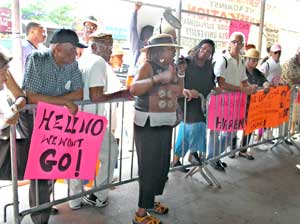First New Orleans, now Harlem?
Developers threaten historic Black community
By
Tony Murphy
Harlem, N.Y.
Published Jul 30, 2006 10:01 PM
Last year the crisis
brought on by Hurricane Katrina exposed the shocking level of New Orleans’
racism and poverty, two forces that trapped people there as much as water.
Driving these forces—and preventing people from returning to their
homes—was gentrification, the desire of landlords and real estate players
to push poor people out of their homes and get richer from the
property.
|
Nellie Bailey speaks for Harlem Tenants Council.
WW photo: Anne Pruden
|
While Katrina exposed and accelerated the process for New
Orleans, the scourge of gentrification is demolishing communities in every
city—some with all the power of a Level 5 hurricane.
Hurricane
Katrina was mentioned frequently by the speakers at a recent anti-gentrification
protest and tenants’ speakout in Harlem. The action, organized by the
Harlem Tenants Council, was part of the group’s dynamic, people-based
campaign of demonstrations, town-hall meetings, teach-ins and community
speakouts designed to stop evictions and landlord harassment in this historic
neighborhood. The campaign is calling for either a moratorium on evictions or a
rent strike.
The July 19 action took place in a unique spot: outside
ex-president Bill Clinton’s Harlem office, located on 125th Street, the
commercial heart of Harlem. Clinton’s 2001 arrival in Harlem was greeted
with much fanfare in the media. However, his pro-corporate policies as
president—the elimination of federal public assistance, for
instance—have made many of the community’s residents
poorer.
Every pedestrian who passed by the protest was handed a leaflet
with the title “President Clinton Can Easily Afford Harlem—How About
You?” The text under that title said, “Illegal evictions, landlord
harassment and soaring rents are driving African Americans out of the historic
Black community of Harlem. While our first ‘Black President’ Bill
Clinton can rent with relative ease in Harlem, so many poor and working families
are barely able to make ends meet.”
The initial crowd was about 60
people. When the action ended three hours later, it had grown to over 100.
Hooked by the leaflet, many passersby stayed to hear tenants’ testimonies
and Harlem Tenants Council leader Nellie Bailey, who educated the crowd about
the New York struggle against gentrification.
Bailey talked about the
area’s increased real estate speculation; the corporatization of
Harlem’s local economy; Columbia University expansion; the glut of luxury
housing; inflated rents; illegal evictions; shrinking housing subsidies; and
public policies tilted overwhelmingly in favor of landlords and
developers.
“The established media has largely ignored the
displacement and soaring evictions occurring throughout Harlem,” Bailey
said. In fact, much of the media has sought to portray the gentrification in
Harlem as a good thing.
A June 2005 article on The Real Deal, a website
for real estate brokers and players, shows what’s been happening there.
Reporting on the opening of a high-end health food store, the article stated,
“The new retail isn’t just confined to food stores—residential
real estate offices are also moving in.”
The article continued,
“By summer, War burg, Corcoran and Douglas Elliman will all have Frederick
Douglass Boulevard offices within a three-block stretch. War burg opened a
2,500-square-foot office in October on Frederick Douglass and 120th Street.
Corcoran is renovating a 1,900-square-foot storefront across the street and
plans to open June 1. Douglas Elliman plans to open its 1,300-square-foot office
at 117th Street ... by July 1. The three offices have desks for between 15 to 20
agents.”
Elliman’s director of sales, Gary Can nata, who will
manage the Harlem office, said, “We’ve looked at the corridor and
the new rentals and condominiums there and we thought having a position in that
lower part of Harlem was a smart move.”
Obviously these offices are
not there to help current residents stay in Harlem.
Bailey said that in
2005 there were 17,413 residential eviction proceedings in Central Harlem and
Washington Heights, and as of March 2006, a total of 21,991 eviction warrants
had been issued in Manhattan Housing Court. “Harlem is a hotbed for real
estate development and speculation,” said Bailey. “Without a doubt
there is ample evidence that longtime Harlem residents are being pushed out and
there is no relief in sight unless tenants take to the streets.”
Articles copyright 1995-2012 Workers World.
Verbatim copying and distribution of this entire article is permitted in any medium without royalty provided this notice is preserved.
Workers World, 55 W. 17 St., NY, NY 10011
Email:
[email protected]
Subscribe
[email protected]
Support independent news
DONATE


